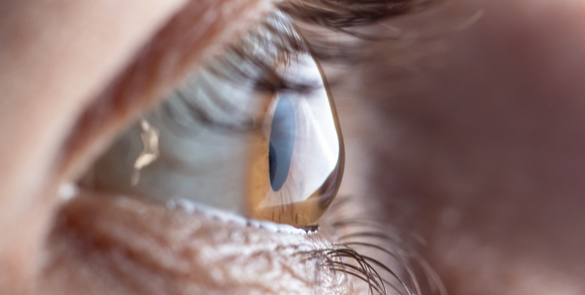What is Keratoconus?
Keratoconus is a progressive eye condition in which the normally round cornea becomes thin and begins to bulge into a cone-like shape. This distortion causes blurry or distorted vision and can significantly affect a person’s ability to see clearly. The condition often develops during adolescence and may progress more quickly if it begins at a younger age or if there is frequent eye rubbing.
At Moorfields Eye Hospital Dubai and Abu Dhabi, our Keratoconus specialists use advanced diagnostic tools and personalised keratoconus treatment options for individuals, supporting long-term eye health and helping patients maintain the best possible vision.

What are the causes and risk factors of Keratoconus?
Keratoconus occurs when the cornea becomes more elastic and begins to thin, which causes it to bulge outward and lose its normal shape. Several factors may contribute to its development:
- Family history: The condition may be inherited, and individuals with a family member affected by keratoconus are at greater risk.
- Allergies and inflammation: Conditions such as hay fever, eczema, and asthma are commonly linked with keratoconus.
- Eye rubbing: Repeatedly rubbing the eyes can significantly accelerate the progression of keratoconus and is strongly discouraged.
Keratoconus affects approximately 1 in 2,000 people worldwide and is more commonly observed in the Middle East.
What are the symptoms of Keratoconus?
Keratoconus often presents with symptoms that vary in severity depending on the progression of the condition and these include:
- Blurry, distorted vision or double vision
- Seeing halos around lights
- Increased sensitivity to light
- Difficulty seeing at night.
- Frequent changes in eyeglass prescriptions
- Increased nearsightedness or astigmatism
Recognising the signs of keratoconus early is crucial for effective management. If left undiagnosed, the condition can progress to a stage where traditional corrective measures, such as eyeglasses or soft contact lenses, may no longer be sufficient.
How is Keratoconus Diagnosed?
Several diagnostic tests are used to confirm the presence of keratoconus and assess its severity. These include:
- Corneal Topography: This non-invasive imaging scan , maps the surface curvature of the cornea, revealing the characteristic cone-shaped irregularities
- Pachymetry: This test measures the thickness of the cornea, which is vital for detecting the progressive thinning that occurs in keratoconus.
- Slit-Lamp Examination: A detailed examination of the cornea using a slit-lamp microscope can reveal signs of keratoconus, such as corneal thinning and scarring.
- Keratometry: This test measures the curvature of the central cornea and helps in detecting abnormalities in its shape.
These tests aid in diagnosing keratoconus, monitoring its progression, and determining the most appropriate treatment options.
Keratoconus treatment options
Non-Surgical Treatments: Eyeglasses and Contact Lenses
In the early stages, vision can often be corrected with eyeglasses or soft contact lenses to provide clear vision.
- Eyeglasses or soft contact lenses: Suitable for mild cases.
- Rigid gas permeable (RGP) contact lenses: Help correct the irregular shape of the cornea as keratoconus progresses.
- Hybrid lenses: Combine the comfort of soft lenses with the clarity of rigid lenses, offering good vision and comfort for many patients.
Advanced Treatments: Corneal Cross-Linking and Surgery
- Corneal Collagen Cross-Linking with Riboflavin (CXL): This treatment strengthens the cornea using Vitamin B2, halting the progression of Keratoconus. The success of this treatment varies, but many patients experience a significant slowdown in the progression of the condition.
- Intracorneal Rings (Intacs & Ferrara): These rings are inserted into the cornea to modify its shape and improve vision. They are used when contact lenses are unsuitable and the cornea is relatively clear. Patients generally see improved vision and a more regular corneal shape post-procedure.
- Phototherapeutic Keratectomy (PTK) combined with corneal cross-linking: This procedure improves corneal surface irregularities when contact lenses are not tolerated..
- Corneal Transplants: Used in advanced stages with corneal scarring, the procedures vary from partial (Deep Anterior Lamellar Keratoplasty—DALK) to full-thickness grafts (Penetrating Keratoplasty—PK). The need for transplants is declining due to early diagnosis and successful early treatments like CXL.
Can Keratoconus be Prevented?
Although keratoconus cannot be entirely prevented, some measures may help slow its progression:
-
- Avoid rubbing the eyes, especially during allergy flare-ups.
- Manage allergic eye conditions with appropriate treatments.
- Wear protective eyewear in dusty or windy environments to reduce the urge to rub the eyes.
Request an Appointment





